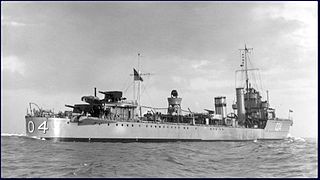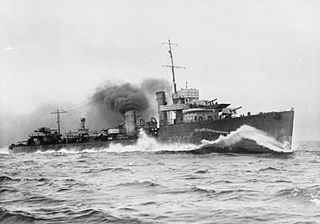Service history
Interwar
After the conclusion of World War I, Wolsey served in the Atlantic Fleet. In the late 1920s, she operated on the China Station. After the British river steamer SS Kutwo collided with and sank a Chinese troop-carrying launch on the Yangtze River and Chinese authorities threatened to seize her at Nanking in early March 1927, Wolsey arrived on the scene and came alongside Kutwo to repel by force any Chinese attempt to board her, and Wolsey's sailors also boarded a British hulk nearby and forced off Chinese students who had boarded it to stage a demonstration; the light cruiser Emerald soon joined Wolsey at Nanking as a reinforcement. [4] During the Nanking Incident, Wolsey steamed at full speed from Wuhu to Nanking on 24 March 1927 to reinforce Emerald and the United States Navy destroyers USS Noa (DD-343) and USS William B. Preston (DD-344) and patrol yacht USS Isabel (PY-10) as they confronted Chinese troops threatening foreigners ashore; she arrived as the other ships opened fire on Chinese positions and, without a target designation for her larger guns, used her machine guns against Chinese snipers which had harassed the other ships and their boats all day. She remained at Nanking, prepared for further action, until all foreign refugees were safely aboard the ships on the evening of 25 March 1927. [5]
By the early 1930s, Wolsey was part of the Mediterranean Fleet. She later was decommissioned and placed in reserve at Malta. [2]
In 1938, the Royal Navy selected her for conversion into an antiaircraft escort destroyer at the Royal Navy Dockyard at Valletta, Malta. [2]
World War II
January – June 1940
Wolsey still was undergoing her conversion and a refit at Malta when the United Kingdom entered World War II on 3 September 1939. In January 1940 she began post-conversion acceptance trials and pre-deployment work-ups at Malta. [2] With all work completed on 21 January 1940, [3] her pennant number was changed to L02, and she was selected for service in home waters. She proceeded from Malta to Gibraltar, where on 29 January 1940, she and the sloop Lowestoft began a voyage to Liverpool as the escort of Convoy HG 17F. Reinforced during the voyage by the sloop Sandwich on 31 January and by the destroyers Broke and Winchelsea from 4 to 5 February, Wolsey and Lowestoft escorted the convoy until its arrival at Liverpool on 7 February 1940. [2]
After her arrival at Liverpool, Wolsey was assigned to Western Approaches Command and began convoy escort and patrol duty in the Western Approaches. On 10 May 1940, she was transferred to the Commander-in-Chief, Dover to support Allied military operations during the German offensive into France, Luxembourg, Belgium, and the Netherlands that began that month. On 13 May, she and the destroyers Boreas, Keith, and Wivern escorted a convoy bringing reinforcements from the United Kingdom for French antiaircraft defenses in ports along the English Channel, and later the same day embarked demolition parties and carried them to Le Havre, France, to destroy port facilities there before advancing German Army forces captured them. On 16 May, she and the destroyer Vimiera bombarded German ground forces at Escault in Offrethun, France, and Wolsey again bombarded Escault on 17 May. [2] On 22 May she and the destroyer Vimy escorted the cargo ship City of Christchurch as City of Christchurch carried heavy motor vehicles and tanks from Southampton to Calais, France. [6] On 23 May, Wolsey embarked a demolition party for Le Havre and then steamed to Calais to assist in the evacuation of British citizens before returning to Dover. [6] On 25 May, she and the destroyer Wolfhound engaged German 150-mm (5.9-inch) howitzers in defence of the evacuation of Calais. [2]
On 26 May 1940, Wolsey was assigned to Operation Dynamo, the evacuation of Allied troops from the beaches at Dunkirk, France. She embarked evacuees from small craft offshore on 27 May and disembarked 102 evacuated troops at Dover on 28 May. She delivered another 315 troops from Dunkirk at Dover on 29 May. On 30 May, she made two evacuation voyages, carrying 616 troops to Dover on the first one and 1,065 on the second. On 31 May while at Dunkirk, she suffered damage when a fire broke out in her degaussing equipment and in a collision with a merchant ship, but despite her damage she deployed offshore to serve as a wireless transmitter link between Dunkirk and Dover and later in the day landed 425 evacuated troops at Dover. She carried another 535 troops from Dunkirk to Dover on 1 June before being withdrawn from evacuation operations later in the day for repairs.
June 1940-Summer 1945
Wolsey proceeded to Portsmouth on 2 June 1940, where she entered the Royal Navy Dockyard on 3 June for repairs. Upon their completion, she began convoy defence operations and anti-invasion patrols in the North Sea in July 1940. In August 1940, she returned to convoy escort duty with the Western Approaches Command. [2]
In January 1941, Wolsey was transferred to the Rosyth Escort Force based at Rosyth, Scotland, to escort coastal convoys in the North Sea and Northwestern Approaches. By October 1941, these duties increasingly included operations to intercept German motor torpedo boats – S-boats, known to the Allies as "E-boats" – before they could attack the convoys. On 12 October 1941, she was part of the escort of the northbound coastal convoy FN 31 in the North Sea along with the destroyer Westminster from the Rosyth Escort Force, the escort destroyer Cotswold from Harwich, and motor gunboats of the Royal Navy Coastal Forces when nine German E-boats of the 2nd Flotilla attacked, sinking the merchant ships SS Chevington and SS Roy; the escorts engaged the E-boats and gave chase as they withdrew, but were unable to destroy any of them. On 19 November 1941, Wolsey joined the southbound coastal convoy FS 50 to escort it to the Thames Estuary along with the destroyers Campbell, Vesper, and Verdun, the escort destroyers Garth and Quorn, and the corvettes Kittiwake and Widgeon. On 20 November, the convoy came under heavy attack by 2nd Flotilla E-boats, which sank the colliers Aruba and Waldinge and the Royal Fleet Auxiliary tanker RFA War Mehtar; the latter, at 11,681 gross register tons, was the largest ship sunk by an E-boat in the North Sea during World War II. [2]
Wolsey was "adopted" by the civil community of Spennymoor in County Durham, England, in a Warship Week national savings campaign in December 1941. She continued on convoy escort and patrol duty in the North Sea – having radar and radio telephone equipment installed in 1942 to improve her ability to detect German aircraft and small surface craft and give her a greater capability to warn other ships of the approach of enemy aircraft and ships and to communicate while manoeuvering – without further major incident until the surrender of Germany in early May 1945. She took no part in any operations related to the Allied invasion of Normandy in the summer of 1944. [2]
After Germany's surrender, Wolsey supported Allied forces reoccupying Norway, and on 14 May 1945 joined the destroyer HMS Vivacious (D36) in escorting minesweepers as they cleared the entrance to Stavanger. [2]

HMS Jaguar was a J-class destroyer of the Royal Navy. Commissioned in September 1939, she was present at the Dunkirk evacuation the following year, during which Jaguar was damaged by dive bombers. She later served in the Mediterranean and was involved in several actions there. She was torpedoed off the coast of Egypt on 26 March 1942 and sunk.

HMS Whitshed (D77/I77) was an Admiralty modified W-class destroyer of the Royal Navy. She was ordered from Swan Hunter & Wigham Richardson Ltd under the 14th Order for Destroyers in the Emergency War Program of 1918–19. She was the first ship to carry the name.

HMS Wild Swan was an Admiralty modified W-class destroyer built for the Royal Navy. She was one of four destroyers ordered in 1918 from Swan Hunter and Wigham Richardson, Wallsend-on-Tyne under the 14th Order for Destroyers of the Emergency War Program of 1917–18. She was the second Royal Navy ship to carry the name, after the sloop HMS Wild Swan in 1876. Like her sisters, she was completed too late to see action in the First World War.

HMS Codrington was one of nine A-class destroyers built for the Royal Navy during the 1920s. She was the flotilla leader for the class. During the Second World War she served in Home waters and off the Norwegian coast, before being bombed and sunk on 27 July 1940 whilst in dock at Dover.

HMS Westminster was a W-class destroyer of the Royal Navy. She was the first ship to bear the name. Launched in 1918, she served through two World Wars, and survived both to be sold for scrap in 1947.

HMS Veteran was an Admiralty modified W-class destroyer built for the Royal Navy. She was ordered in April 1918 from John Brown & Company under the 14th War Program. She was the third Royal Navy ship to carry the name.

HMS Vancouver was a British V-class destroyer. She was launched on 28 December 1917; in July 1922 she accidentally rammed the submarine H24. She was renamed HMS Vimy in April 1928. She served with distinction during World War II, earning two battle honours and damaging or sinking three enemy submarines. The Royal Navy retired her in 1945 and she was scrapped in 1948.

HMS Vimiera was a V-class destroyer ordered as part of the 1917–18 programme.

HMS Witherington was an Admiralty modified W-class destroyer built for the Royal Navy. She was one of four destroyers ordered in April 1918 from James Samuel White & Co Ltd. under the 14th Order for Destroyers of the Emergency War Program of 1917–18. She was the first Royal Navy ship to carry this name.

HMS Vesper was a V-class destroyer of the British Royal Navy that saw service in World War I and World War II.

HMS Vivacious (D36) was a V-class destroyer of the British Royal Navy that saw service in World War I and World War II.

HMS Vanessa (D29) was a V-class destroyer of the British Royal Navy that was in service during World War I and World War II.

HMS Vanquisher (D54) was a V-class destroyer of the British Royal Navy that saw service in World War I and World War II.

The second HMS Vega was a V-class destroyer of the British Royal Navy that saw service in World War I and World War II.
HMS Venetia (D53) was a V-class destroyer of the British Royal Navy that saw service in World War I and World War II.

HMS Venomous (ex-Venom), was a Modified W-class destroyer of the British Royal Navy that saw service in the Russian Civil War and World War II.

HMS Versatile (D32) was an Admiralty V-class destroyer of the British Royal Navy that saw service in World War I, the Russian Civil War, and World War II.

The third HMS Windsor (D42) was a W-class destroyer of the British Royal Navy that saw service in the final months of World War I and in World War II.

HMS Whitehall, pennant number D94, later I94, was a Modified W-class destroyer of the British Royal Navy that saw service in the Second World War.

The eighth HMS Worcester, was a Modified W-class destroyer of the British Royal Navy that saw service in World War II. She later served as an accommodation ship as the second HMS Yeoman.
This page is based on this
Wikipedia article Text is available under the
CC BY-SA 4.0 license; additional terms may apply.
Images, videos and audio are available under their respective licenses.



















